100 years ago the Telegraph Office was Dunedin’s commercial nerve centre.
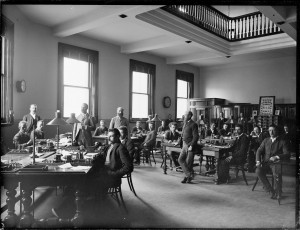
Every telegraph clerk learned his standard commercial codes in order both to abbreviate telegrams and to preserve the security of sensitive information. Telegraph Office, Dunedin. Williams, Edgar Richard, 1891-1983 :Negatives, lantern slides, stereographs, colour transparencies, monochrome prints, photographic ephemera. Ref: 1/1-025835-G. Alexander Turnbull Library, Wellington, New Zealand. http://natlib.govt.nz/records/22335890
Fast and efficient communication was a recurrent challenge for the inhabitants of Dunedin. However, the discovery of gold brought some 64,000 immigrants to the region between 1861 and 1863, fuelling an economic boom that not only prompted an expansion of commercial activity but also drove the emergence of a range of increasingly specialized enterprises. Accordingly outward mail from Otago increased 350% between 1860 and 1864, more than one quarter making its way to Victoria, where many miners had families or business interests.
While hand-written letters remained vital in maintaining contact between individuals a day or more apart, the telegraph captured the popular imagination as the world’s first form of instant communication. After spreading rapidly around the world during the 1850s, the telegraph finally reached New Zealand in July of 1862 when Christchurch and Lyttleton were connected. In Dunedin, local business interests and newspapers had been agitating for speedy communication with Port Chalmers, the district’s main port of call, as well as with the goldfields in the hinterland. Thanks to the efforts of Julius Vogel and Provincial Superintendent James Macandrew, the line from Port Chalmers to Dunedin was established in August 1862, erected by a local firm Messrs Driver & Co.
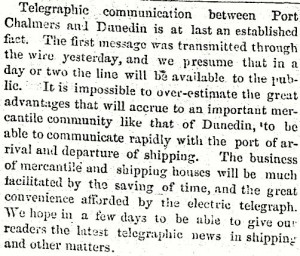
Connected! The creation of the Port Chalmers-Dunedin telegraph line announced in the Otago Daily Times,16 August 1862, 4.
Dunedin’s first telegraph office, “a small cottage of a familiar type”, was established in Lower High Street and managed by Messrs. Driver & Maclean. The first government telegraph office was however, “nothing more nor less than a sentry box” situated between the Driver & Maclean’s office and the Custom House. Formerly this modest structure had been used to shelter the armed constables who guarded the gold deposited in the Customs building. It contained only enough elbow-room for one, requiring two of the three officers to wait on the footpath whenever a telegram was being transcribed. These Dunedin offices were nodes in a rapidly growing network, as telegraph lines were being extended to all the principal centres and, in turn, lines were quickly reaching out into the hinterland from these major site of settlement. The first Cook Strait cable, a crucial link in the entire system, was laid in August 27, 1866. By the end of the decade the South Island was comprehensively linked by telegraph.

Humble beginnings. A sketch by J.E Green shows Dunedin’s first telegraph facilities, the “little sentry box” barely visible between customs house and the weatherboard office on the left. “Scrapbook of Newspaper Clippings…”, Variae V.35, S14-69a, 1928-1948, Hocken Collections, Uare Taoka o Hakena, University of Otago.
Early in 1866 Dunedin’s sentry box was superseded by a larger weatherboard shed on the corner of Bond Street, which was then on the waterfront. Ngāi Tahu fishermen drove a brisk trade selling barracouta and other fish caught from the Heads, pulling their canoes up onto the beach and conducting business through the office windows!
Although it was later superseded by a grand building in 1877, Dunedin’s humble weatherboard telegraph office was, in fact, a key site in New Zealand’s first “hacking” scandal. This was initiated by the arrival of news in October 1870 that Napoleon was imprisoned in Germany and that France had been declared a republic. For Dunedin’s European-born population these were momentous developments as detailed by the Otago Daily Times: “a greater degree of excitement [had] never been witnessed in Dunedin… a crowd of two or three hundred literally besieged our doors, waiting for three or four hours at least until the telegrams were published”.
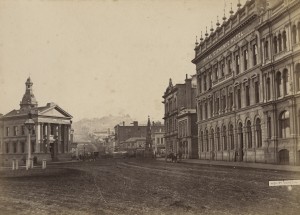
In 1877 the Weatherboard office was demolished and a “more imposing edifice” erected in it’s place (far left). Fast and reliable communication facilitated massive commercial and industrial expansion in Dunedin, the results of which can be seen in the resplendent appearance of the office and the Royal Exchange Hotel to the right. S15-012a, “Dunedin, High Street”, [ca. 1890], messrs. F. Bradley & Co., c/nE2336/6, Hocken Collections, Uare Taoka o Hakena, University of Otago.
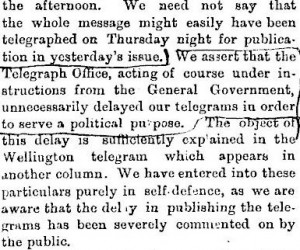
Libel! ODT editor G.B. Barton protests against a tactical telegram delay, provoking the wrath of the government in a very public libel suit. The outlining was present in the scanned original of the newspaper, proof of its importance. The Otago Daily Times, 1 October 1870.
Political controversies aside, telegraph technology was seized upon by local firms such as Dalgety Ltd. and the Union Steam Ship Co., which developed their own private codes. Such enterprises flourished with the benefits of fast and reliable communication, and in turn, telegraph returns provided functioned as reliable barometers of economic growth. Figures throughout the 1860s and 70s confirmed Dunedin’s reputation as New Zealand’s commercial capital and they are a strong reminder of the long-standing connections between communications and commerce.
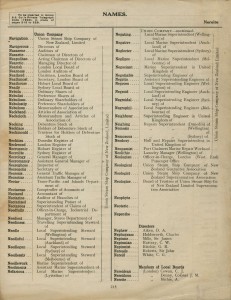
Confidentiality and Compression: Sparing expense and preserving commercial secrecy was the aim of the game. The Union Steam Ship Company’s elaborate 515 page telegraph code book did just that- condensing “Assistant General Manager of…” to “Necromancy” and “Auditor of Branches of…” to “Nectarine.” Hocken Collections, Uare Taoka o Hakena, University of Otago.
Violeta Gilabert
References:
Walter, I. M., “Improvements in New Zealand’s Overseas Communications, 1866-1880, and their Relation to the Country’s Development”. M.A. diss., The University of Otago, 1969.
Wilson, A. C. “Telecommunications- Business and Cable Networks”, Te Ara- The Encyclopedia of New Zealand, updated 13.07.2021, URL: http://www.TeAra.govt.nz/en/telecommuncations/pate-3
Wilson, A. C. Wire & Wireless: A History of Telecommunications in New Zealand 1890-1987. Palmerston North: Dunmore Press, 1994.
Wilton, Dave. “The Great New Zealand Telegram Hacking Scandal (1871): A Shakespearian Comedy inMultiple Parts” in New Zealand History. URL: www.nzhistory.net.nz/files/documents/telegram-hacking-scandal.pdf, retrieved 12.1.2015

